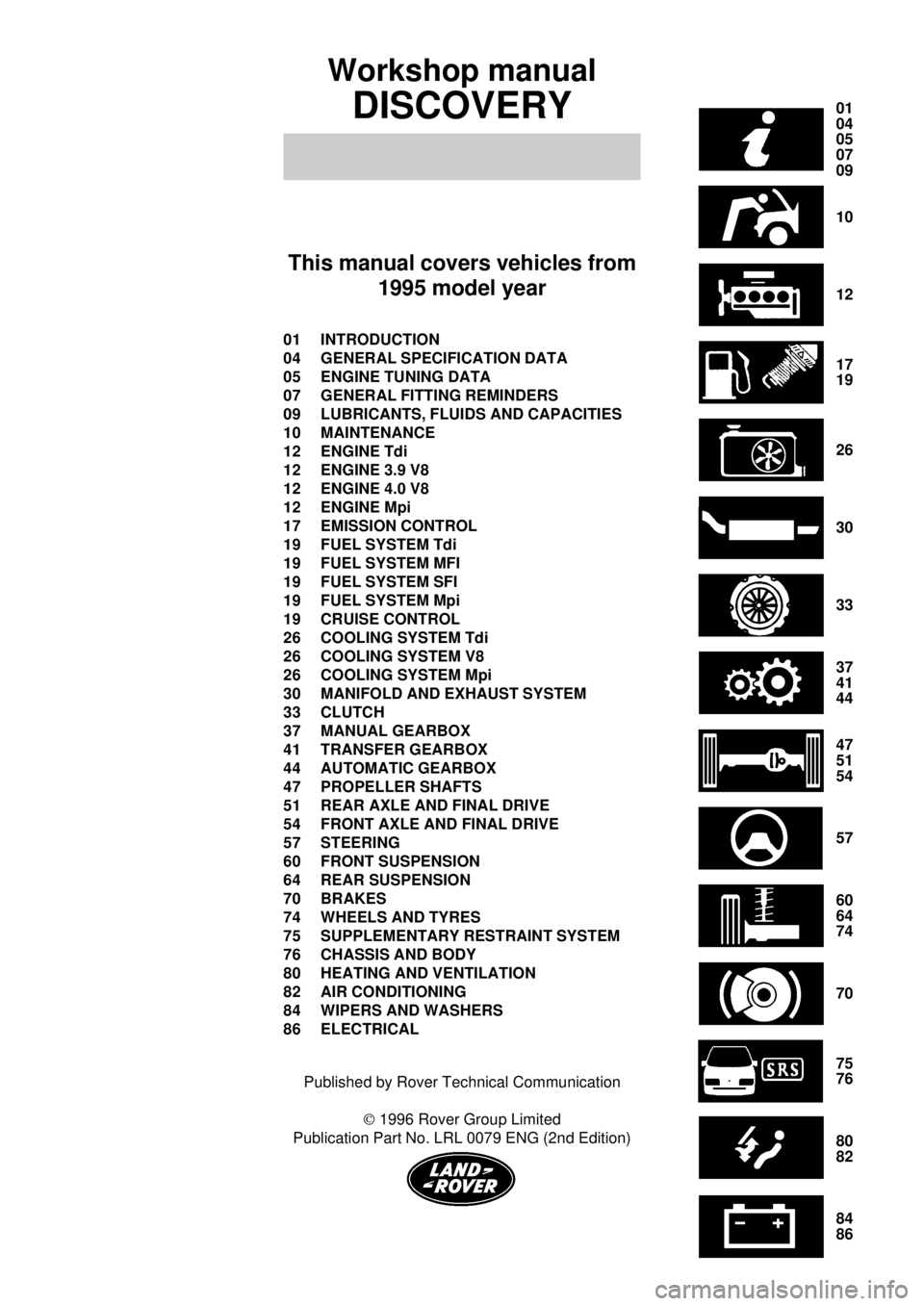1995 LAND ROVER DISCOVERY suspension
[x] Cancel search: suspensionPage 2 of 976

01
04
05
07
09
10
12
17
19
26
30
33
37
41
44
47
51
54
57
60
64
74
70
75
76
80
82
84
86
Workshop manual
DISCOVERY
This manual covers vehicles from
1995 model year
01 INTRODUCTION
04 GENERAL SPECIFICATION DATA
05 ENGINE TUNING DATA
07 GENERAL FITTING REMINDERS
09 LUBRICANTS, FLUIDS AND CAPACITIES
10 MAINTENANCE
12 ENGINE Tdi
12 ENGINE 3.9 V8
12 ENGINE 4.0 V8
12 ENGINE Mpi
17 EMISSION CONTROL
19 FUEL SYSTEM Tdi
19 FUEL SYSTEM MFI
19 FUEL SYSTEM SFI
19 FUEL SYSTEM Mpi
19 CRUISE CONTROL
26 COOLING SYSTEM Tdi
26 COOLING SYSTEM V8
26 COOLING SYSTEM Mpi
30 MANIFOLD AND EXHAUST SYSTEM
33 CLUTCH
37 MANUAL GEARBOX
41 TRANSFER GEARBOX
44 AUTOMATIC GEARBOX
47 PROPELLER SHAFTS
51 REAR AXLE AND FINAL DRIVE
54 FRONT AXLE AND FINAL DRIVE
57 STEERING
60 FRONT SUSPENSION
64 REAR SUSPENSION
70 BRAKES
74 WHEELS AND TYRES
75 SUPPLEMENTARY RESTRAINT SYSTEM
76 CHASSIS AND BODY
80 HEATING AND VENTILATION
82 AIR CONDITIONING
84 WIPERS AND WASHERS
86 ELECTRICAL
Published by Rover Technical Communication
Ó1996 Rover Group Limited
Publication Part No. LRL 0079 ENG (2nd Edition)
Page 3 of 976

INTRODUCTION
1
INFORMATION INTRODUCTION
This workshop manual covers vehicles from 1995
model year onwards. Amendments and additional
pages will be issued to ensure that the manual
covers latest models. Amendments and additions
will be identified by the addition of a dated footer
at the bottom of the page.
This Workshop Manual is designed to assist skilled
technicians in the efficient repair and maintenance of
Land Rover vehicles.
Individuals who undertake their own repairs
should have some skill and training, and limit
repairs to components which could not affect the
safety of the vehicle or its passengers. Any
repairs required to safety critical items such as
steering, brakes, suspension or supplementary
restraint system should be carried out by a Land
Rover Dealer. Repairs to such items should
NEVER be attempted by untrained individuals.
WARNINGS, CAUTIONSandNOTESare given
throughout this Manual in the following form:
WARNING: Procedures which must be
followed precisely to avoid the possibility
of personal injury.
CAUTION: This calls attention to
procedures which must be followed to
avoid damage to components.
NOTE: This calls attention to methods
which make a job easier or gives helpful
information.
DIMENSIONS
The dimensions quoted are to design engineering
specification. Alternative unit equivalents, shown in
brackets following the dimensions, have been
converted from the original specification.REFERENCES
References to the left or right hand side in the manual
are made when viewing the vehicle from the rear.
With the engine and gearbox assembly removed, the
water pump end of the engine is referred to as the
front.
To reduce repetition, some operations covered in this
Manual do not include reference to testing the vehicle
after repair.
It is essential that work is inspected and tested after
completion and if necessary a road test of the vehicle
is carried out particularly where safety related items
are concerned.
REPAIRS AND REPLACEMENTS
When replacement parts are required it is essential
that Land Rover parts are used.
Attention is particularly drawn to the following points
concerning repairs and the fitting of replacement parts
and accessories: Safety features embodied in the
vehicle may be impaired if other than Land Rover
parts are fitted. In certain territories, legislation
prohibits the fitting of parts not to the vehicle
manufacturer's specification. Torque spanner values
given in the Workshop Manual must be strictly
adhered to. Locking devices, where specified, must be
fitted. If the efficiency of a locking device is impaired
during removal it must be replaced with a new one.
Certain fasteners must not be re-used. These
fasteners are specified in the Workshop Manual.
POISONOUS SUBSTANCES
Many liquids and other substances used are
poisonous and therefore must not be consumed. It is
also advisable to keep all substances away from open
wounds. These substances among others include
anti-freeze, brake fluid, fuel, windscreen washer
additives, air conditioning refrigerant, lubricants and
various adhesives.
Page 6 of 976

01INTRODUCTION
4
INFORMATION ACCESSORIES AND CONVERSIONS
DO NOT FITunapproved accessories or conversions,
as they could affect the safety of the vehicle.
Land Rover will not accept liability for death, personal
injury, or damage to property which may occur as a
direct result of the fitting of non-approved conversions
to the vehicle.
WHEELS AND TYRES
WARNING: DO NOT replace the road
wheels with any type other than genuine
Land Rover wheels which are designed for
multi-purpose on and off road use and have very
important relationships with the proper operation
of the suspension system and vehicle handling.
Replacement tyres must be of the make and sizes
recommended for the vehicle, and all tyres must
be the same make, ply rating and tread pattern.
STEAM CLEANING
To prevent consequential rusting, any steam cleaning
within the engine bayMUSTbe followed by careful
re-waxing of the metallic components affected.
Particular attention must be given to the steering
column, engine water pipes, hose clips and ignition
coil clamp.
SPECIFICATION
The specification details and instructions set out in
this Manual apply only to a range of vehicles and not
to any one. For the specification of a particular vehicle
purchasers should consult their Dealer
The Manufacturer reserve the right to vary their
specifications with or without notice, and at such times
and in such manner as they think fit. Major as well as
minor changes may be involved in accordance with
the Manufacturer's policy of constant product
improvement.
Whilst every effort is made to ensure the accuracy of
the particulars contained in this Manual, neither the
Manufacturer or Dealer, by whom this Manual is
supplied, shall in any circumstances be held liable for
any inaccuracy or the consequences thereof.SPECIAL SERVICE TOOLS
The use of approved special service tools is
important. They are essential if service operations are
to be carried out efficiently, and safely. Where special
tools are specified,only these tools should be used
to avoid the possibility of personal injury or
damage to the components.Also the amount of time
which they save can be considerable.
Every special tool is designed with the close
co-operation of Land Rover, and no tool is put into
production which has not been tested and approved
by us. New tools are only introduced where an
operation cannot be satisfactorily carried out using
existing tools or standard equipment. The user is
therefore assured that the tool is necessary and that it
will perform accurately, efficiently and safely.
Special tools bulletins will be issued periodically giving
details of new tools as they are introduced.
All orders and enquiries from the United Kingdom
should be sent direct to V. L. Churchill. Overseas
orders should be placed with the local V. L. Churchill
distributor, where one exists. Countries where there is
no distributor may order direct from:
V. L. Churchill Limited,
PO Box 3,
Daventry, Northants,
England, NN11 4NF.
The tools recommended in this Workshop Manual are
listed in a multi-language illustrated catalogue,
obtainable from:
Messers. V. L. Churchill at the above address,
or from:
Land Rover Merchandising Service,
PO Box 534,
Erdington,
Birmingham, B24 0Q5,
COPYRIGHT
ÓLand Rover 1996
All rights reserved. No part of this publication may be
produced, stored in a retrieval system or transmitted
in any form, electronic, mechanical, recording or other
means without prior written permission of Land Rover.
Page 29 of 976

GENERAL SPECIFICATION DATA
11
INFORMATION SUSPENSION
Type Coil springs controlled by telescopic dampers front.................................................................................
and rear.
Front Lateral location of axle by Panhard rod, and.................................................................................
longitudinal location by two radius arms.
Rear Lateral location of axle by a centrally positioned 'A'.................................................................................
frame bolted at the apex to a ball joint mounting.
Longitudinal location of axle by two tubular trailing
links.
ROAD SPRING DATA
V8i - Mpi
LEFT HAND DRIVE Part No Colour Code
Left hand front NRC 4306 Blue/White
Right hand front 572315 Blue
Left/Right hand rear ANR 3477 or Brown/Green
ANR 4352 Orange/Orange *
RIGHT HAND DRIVE Part No Colour Code
Left hand front 572315 Blue
Right hand front 572315 Blue
Left/Right hand rear ANR 3477 or Brown/Green
ANR 4352 Orange/Orange *
Tdi Diesel
RIGHT HAND DRIVE Part No Colour Code
Left hand front ANR 1975 or Blue/Pink/Red
ANR 4350 Brown/Brown **
Right hand front ANR 1976 or Blue/Pink/Yellow
ANR 4351 Grey/Grey **
Left/Right hand rear ANR 3477 or Brown/Green
ANR 4352 Orange/Orange *
LEFT HAND DRIVE Part No Colour Code
Left hand front ANR 1976 or Blue/Pink/Yellow
ANR 4351 Grey/Grey **
Right hand front ANR 1975 or Blue/Pink/Red
ANR 4350 Brown/Brown **
Left/Right hand rear ANR 3477 or Brown/Green
ANR 4352 Orange/Orange *
* VIN 119534 onwards
** VIN 116461 onwards
Page 78 of 976

10MAINTENANCE
16
MAINTENANCE
LUBRICATE PROPELLER SHAFT SLIDING , AND
UNIVERSAL JOINTS
1.Clean all grease nipples on front and rear
propeller shafts.
2.Using a low pressure hand grease gun, apply
recommended grease, to grease nipples at front
and rear propeller shaft universal and sliding
joints.
NOTE: The rear propeller shaft flexible
coupling is not fitted with a grease nipple.
CHECK VISUALLY BRAKE, FUEL, CLUTCH
PIPES/UNIONS FOR CHAFING LEAKS AND
CORROSION
CHECK EXHAUST SYSTEM FOR LEAKS,
SECURITY AND DAMAGE
CHECK FOR FLUID LEAKS FROM POWER
STEERING AND SUSPENSION SYSTEMS,
HYDRAULIC PIPES AND UNIONS FOR CHAFING
AND CORROSION
CHECK/TIGHTEN STEERING UNIT AND STEERING
ROD BALL JOINT FIXINGS, CHECK CONDITION
OF OF BALL JOINTS AND DUST COVERS
Ball joints are lubricated for their normal life during
manufacture and require no further lubrication. This
applies ONLY if rubber boot has not been dislodged
or damaged. Joints should be checked at specified
mileage intervals but more frequently if vehicle is used
under arduous conditions.
1.Check for wear in joints by moving ball joint up
and down vigorously. If free movement is
apparent fit a new joint assembly.
Page 79 of 976

MAINTENANCE
17
MAINTENANCE
CHECK/TIGHTEN FRONT AND REAR AXLE
SUSPENSION LINK FIXINGS, CHECK CONDITION
OF MOUNTING RUBBERS
DRAIN FUEL SEDIMENTER - Tdi
Fuel sedimenter
The sedimenter is attached to left-hand side of
chassis frame near fuel tank. It increases the working
life of the fuel filter by removing larger droplets of
water and larger particles of foreign matter from fuel.
Drain off water
1.Loosen drain plug, allow water to run out.
Tighten plug immediately pure diesel fuel starts
to flow.
RENEW FUEL FILTER
WARNING: Ensure that fuel handling
precautions given in Section 01 -
Introduction regarding fuel handling are
strictly adhered to when carrying out following
instructions.
See INTRODUCTION, Information,
Fuel Handling Precautions
WARNING: The spilling of fuel is
unavoidable during this operation. Ensure
that all necessary precautions are taken to
prevent fire and explosion.
1.Depressurise fuel system.
See FUEL SYSTEM,
Repair, Depressurising Fuel System
2.The fuel line filter is located on right hand
chassis side member forward of fuel tank filler
neck. Access to filter is gained through right
hand rear wheel arch.
3.Thoroughly clean area around hose connections
to prevent ingress of foreign matter into fuel
system.
4.Loosen two fuel unions and remove hoses from
filter canister.
5.Release securing bolt and bracket, remove filter
from chassis side member.
6.Fit a new filter observing direction of flow arrow
on canister.
7.Fit inlet and outlet hoses. Tighten to
30 Nm.
8.Refit fuel pump relay.
9.Reconnect battery negative lead.
10.Recode radio.
11.Start engine and inspect hose connections for
fuel leaks.
Page 84 of 976

Tdi
3
REPAIR ENGINE
Service repair no - 12.41.01
Remove
CAUTION: Seal all exposed pipe ends
against ingress of dirt after disconnection.
1.Park vehicle on level ground and apply park
brake.
2.Disconnect battery negative lead.
3.Remove bonnet [hood].
See CHASSIS AND
BODY, Repair, Bonnet [Hood]
4.If air conditioning is fitted, remove RH footwell
side trim panel and disconnect harness multiplug
from relay.
5.Disconnect the two engine harness multiplugs
on LH side of footwell.
6.Remove engine harness grommet from
bulkhead and move harness into engine bay.
7.Release battery positive lead from retaining clip
at base of suspension turret.
8.Remove Radiator Assembly.
See COOLING
SYSTEM, Repair, Radiator
9.Discharge air conditioning system.See AIR
CONDITIONING, Adjustment, Refrigerant
Recovery Recycling Recharging
Remove retaining bolts and disconnect both pipe
adaptors from rear of compressor.
10.Remove rocker cover insulation.
11.Disconnect cyclone hose from air cleaner hose.
12.Remove air cleaner hose from turbocharger.
13.Remove feed pipe/hose from turbocharger and
intercooler.
14.Disconnect heater hoses from cylinder head and
heater rails.
15.Remove bolt securing transmission breather
pipe clip to cylinder head; move breather pipes
aside.
16.Disconnect inlet and outlet hoses from power
steering pump.
17.Disconnect bypass hose from thermostat
housing.
18.Release bypass hose from retaining clips on
front timing cover.
19.Remove split pin securing inner throttle cable to
injector pump.
20.Depress tags on outer cable adjusting nut,
remove cable from mounting bracket, and move
aside.
21.If automatic transmission is fitted, release
kickdown cable from injector pump and mounting
bracket.
Page 283 of 976

SFI
1
ADJUSTMENT ENGINE TUNING
Service repair no - 19.22.13
The position of the Idle Air Control (IAC) valve can be
checked using TestBook and adjusted if necessary
through the by-pass screw in the plenum chamber.
The bypass screw is covered by a tamper proof plug
which can be extracted using a self tapping screw.
All vehicles:
1.Ensure air conditioning and all electical loads are
off. Vehicle must be in neutral or park with air
suspension in kneel and disabled.
2.Carry out tuning or base idle setting procedure
as applicable using TestBook.